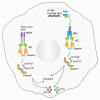Innate immune sensing of DNA viruses
- PMID: 21334037
- PMCID: PMC3070751
- DOI: 10.1016/j.virol.2011.02.003
Innate immune sensing of DNA viruses
Abstract
DNA viruses are a significant contributor to human morbidity and mortality. The immune system protects against viral infections through coordinated innate and adaptive immune responses. While the antigen-specific adaptive mechanisms have been extensively studied, the critical contributions of innate immunity to anti-viral defenses have only been revealed in the very recent past. Central to these anti-viral defenses is the recognition of viral pathogens by a diverse set of germ-line encoded receptors that survey nearly all cellular compartments for the presence of pathogens. In this review, we discuss the recent advances in the innate immune sensing of DNA viruses and focus on the recognition mechanisms involved.
Copyright © 2011 Elsevier Inc. All rights reserved.
Figures



References
-
- Appledorn DM, Patial S, McBride A, Godbehere S, Van Rooijen N, Parameswaran N, Amalfitano A. Adenovirus vector-induced innate inflammatory mediators, MAPK signaling, as well as adaptive immune responses are dependent upon both TLR2 and TLR9 in vivo. J Immunol. 2008;181(3):2134–44. - PubMed
-
- Aravalli RN, Hu S, Rowen TN, Palmquist JM, Lokensgard JR. Cutting edge: TLR2-mediated proinflammatory cytokine and chemokine production by microglial cells in response to herpes simplex virus. J Immunol. 2005;175(7):4189–93. - PubMed
Publication types
MeSH terms
Substances
Grants and funding
LinkOut - more resources
Full Text Sources
Other Literature Sources
Miscellaneous

